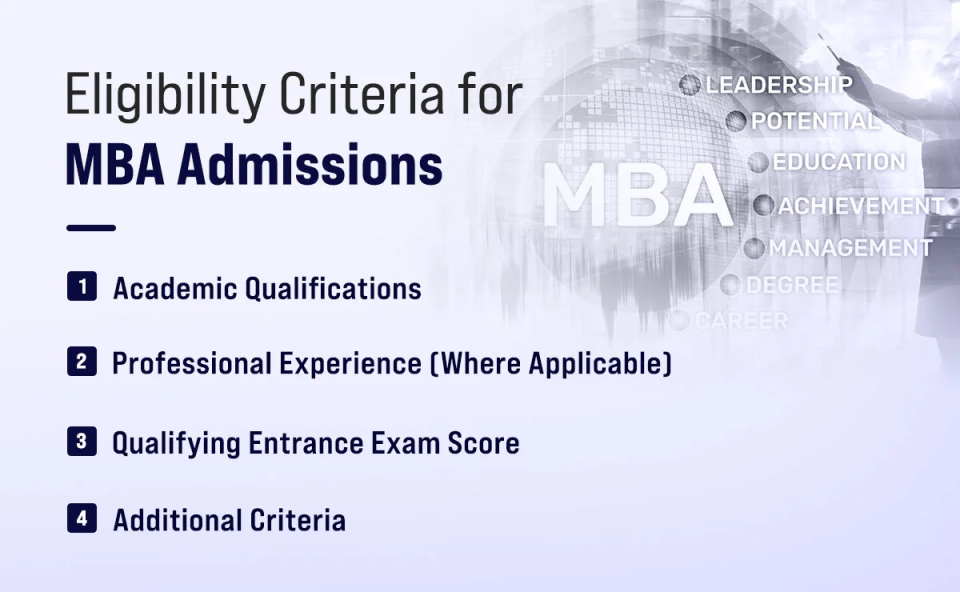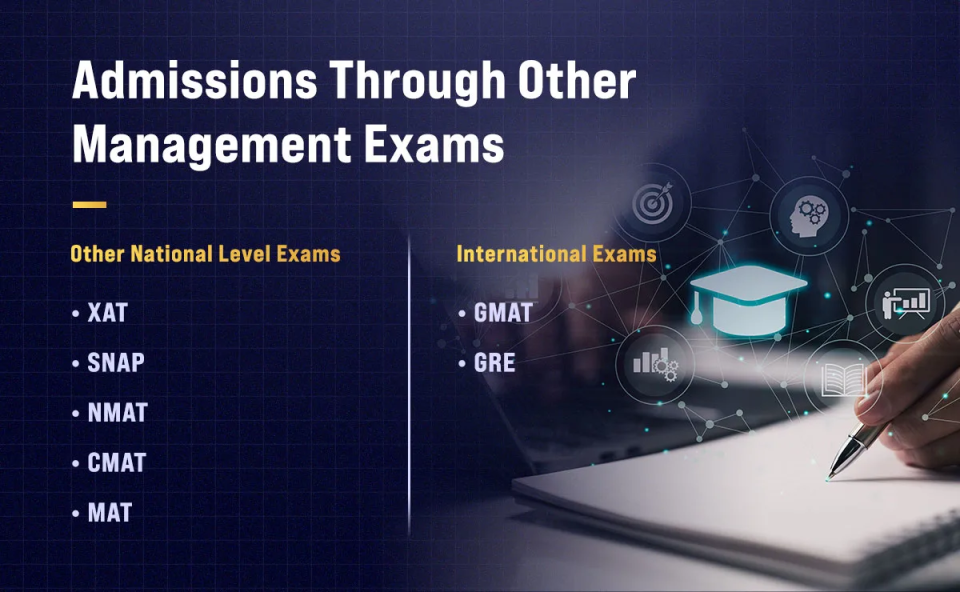Is CAT Compulsory for an MBA?

Every year around 2 lakh aspirants set their sights on an MBA, dreaming of global careers, leadership roles, and the prestige that comes with top B-schools. At the heart of this journey lies a crucial question. Is the Common Admission Test (CAT) compulsory for an MBA?
While CAT is the undisputed gateway to the Indian Institutes of Management (IIMs) and a golden ticket to other premier B‑schools in the country, it is not the only path to management education. Across India, dozens of reputable institutions recognize alternative entrance exams like XAT, NMAT, SNAP, CMAT, GMAT, etc.
Alternatively, some private universities offer seats through direct (management quota) admissions based on academic performance, work experience, and internal evaluations. Yet one principle remains unchanged: no credible MBA program admits students without some form of entrance or aptitude assessment.
In this article, we’ll unravel the role of CAT, explore its alternatives, and equip you with the insights needed to chart the MBA pathway that best aligns with your strengths, timeline, and career aspirations.
Eligibility Criteria for MBA Admissions
Before you embark on your MBA journey, it’s important to ensure you meet the fundamental requirements that most B‑schools enforce. While specific cutoffs and additional conditions may vary from one institution to another, the core eligibility benchmarks typically include:

1) Academic Qualifications
- Undergraduate Degree: You must hold a bachelor’s degree (10+2+3 or 10+2+4) from a recognized university or institute.
- Minimum Marks: Most premier B‑schools require at least 50% aggregate in your bachelor’s program (45%–50% for reserved‑category candidates).
2) Professional Experience (Where Applicable)
- Preferred Work Tenure: While fresh graduates can apply to two‑year MBA programs directly, some colleges, especially those offering executive or part‑time MBAs, ask for 1–3 years of full‑time work experience.
3) Qualifying Entrance Exam Score
To secure a shortlist, you’ll need to achieve a competitive score on at least one nationally or internationally recognized management exam:
- CAT (Common Admission Test): Mandatory for all IIMs and accepted by 1,200+ Indian B‑schools.
- XAT (Xavier Aptitude Test): Conducted by XLRI; gateway to XLRI, IMT Ghaziabad, XIMB Bhubaneswar, and other member institutes.
- NMAT: Flexible test‑date window; preferred by NMIMS Mumbai and several other international schools.
- SNAP (Symbiosis National Aptitude Test): Essential for securing admission into MBA/PGDM programs offered by Symbiosis International University.
- CMAT (Common Management Admission Test): NTA‑administered; accepted by AICTE‑approved institutions nationwide.
- GMAT (Graduate Management Admission Test) & GRE (Graduate Record Examination): Essential for most overseas MBA programs and increasingly recognized by top Indian institutes like ISB Hyderabad.
4) Additional Criteria
- Group Discussions (GD): Evaluate your teamwork, leadership, and articulation in dynamic scenarios.
- Written Ability Test (WAT): Assesses your ability to think critically and present coherent arguments in writing.
- Personal Interview (PI): Explores your career goals, past experiences, and cultural fit with the institute.
- Diversity Factors: Many colleges process applications holistically, giving weightage to gender diversity, academic background (engineering vs. non‑engineering), and co‑curricular achievements.
Is CAT Compulsory for an MBA from the IIMs?
For Indian applicants seeking entry into the flagship two-year PGP/MBA programs at the IIMs, successful completion of the CAT examination is an indispensable prerequisite. It is a gateway for admission to all 21 IIM campuses across India. It is widely recognized as India's most credible and accepted MBA entrance examination, due to its direct conduct by the IIMs themselves.
However, it is important to recognize that certain executive or specialized IIM programs, alongside international applicants to flagship programs, may consider alternative standardized examinations such as the Graduate Management Admission Test (GMAT).
Beyond the initial CAT score, the IIM selection process involves a holistic evaluation of a candidate's profile, including the Written Ability Test (WAT), Group Discussion (GD), Personal Interview (PI), academic history, professional experience, and various diversity considerations. The IIM admission cycle follows a well-defined schedule:
- Notification & Registration (August–September): IIMs release the CAT notification, outlining application deadlines, exam structure, and eligibility criteria (minimum 50% in bachelor's degree for general category).
- Preparation & Mock Tests (August–November): During this period, candidates enroll in coaching programs, attempt practice tests, and refine their strategies for key sections—Quantitative Ability, Data Interpretation & Logical Reasoning, and Verbal Ability & Reading Comprehension.
- Exam Day (Late November): CAT is a three-hour computer-based test with 68 questions across three sections under strict time limits.
- Score Announcement (December): Percentile scores are released, determining shortlists for each IIM's next round.
- Shortlisting & Selection Rounds (January–April): Based on CAT percentile, academics, work experience, and diversity factors. Written Ability Tests, Group Discussions, and Personal Interviews are part of this selection process.
- Final Admissions (May): Offers are rolled out, and incoming batches are finalized.
Importance of CAT Exam in MBA Admission
The prestige and widespread nature of the CAT exam make it the de facto gold standard for many top‑tier B‑schools across India. Here’s why CAT commands such respect:
1) Standardized Assessment of Foundational Skills
CAT rigorously evaluates critical competencies like quantitative ability, data interpretation, logical reasoning, verbal ability, and reading comprehension under strict time constraints. These are all foundational skills that are absolutely crucial to an MBA journey.
Subjecting all candidates to the same high‑stakes environment ensures a level playing field where performance is measured purely on analytical rigor, problem‑solving speed, and accuracy. This standardized approach enables institutions to effectively evaluate a vast pool of applicants with varied academic and professional experiences.
2) Access to Elite Institutes and Enhanced Placement Prospects
Clearing CAT with a strong percentile unlocks admission to the Indian Institutes of Management (IIMs), the country’s most coveted B‑schools, and over 1,200 other leading institutions such as FMS Delhi, MDI Gurgaon, SPJIMR Mumbai, and more.
These campuses attract premier recruiters (McKinsey, BCG, Goldman Sachs, HUL, etc.), translating high CAT percentiles into richer placement pools, pre‑placement offers, and superior average salary packages. In this way, CAT performance often directly influences the quality of peer group, faculty exposure, and career launchpad.
3) Skill Enhancement Beyond Academics
Rigorous CAT preparation reinforces foundational concepts in mathematics, logical reasoning, and verbal comprehension, equipping candidates with enduring analytical and decision‑making skills. These are all qualities that are indispensable to the real‑world of management.
Practicing logical reasoning and quantitative problem‑solving also strengthens critical thinking, enabling aspirants to tackle complex business scenarios and case studies during internships, group discussions, and classroom projects.
4) Network and Scholarship Opportunities
Successfully completing CAT with a high percentile provides entry to top colleges with vibrant and talented peers, seasoned faculty, and industry leaders. This network fosters mentorship, collaborative learning, and access to high‑value internships. Additionally, many institutes offer merit‑based scholarships and financial aid to top CAT performers, reducing financial barriers and rewarding academic excellence.
5) High Relevance and Adaptability
The CAT exam pattern and syllabus are periodically updated to reflect the dynamic and evolving demands of the corporate world. By regularly incorporating new question types and difficulty levels, CAT ensures that aspirants stay attuned to emerging analytical methodologies and business trends, nurturing an adaptable mindset critical for long‑term career success.
Pros and Cons of Skipping the CAT Exam
Consider the factors mentioned below to make a clear decision if you want to skip the CAT exam.
Pros of Skipping CAT | Cons of Skipping CAT |
You can channel your efforts into exams that align more closely with your target institutes. For instance, XAT is used for XLRI, NMAT for NMIMS, and SNAP for Symbiosis. | Instead of now preparing for one exam season, you may have to juggle several test windows (XAT in January, NMAT in December, CMAT in February), stretching your preparation timeline. |
Opens doors to a wider array of international MBA programs, as exams like GMAT and GRE are globally accepted by thousands of institutions across numerous countries. | For Indian applicants, the CAT is mandatory for admission to the flagship two-year PGP/MBA programs at all 21 IIMs. Skipping CAT means these specific institutes are generally inaccessible. |
Allows candidates to choose an exam that aligns better with their individual aptitude and strengths; for instance, GMAT is often considered less mathematically intense than CAT, while GRE emphasizes verbal ability and analytical writing. | The CAT holds the highest credibility in India due to its direct conduct by the IIMs themselves. Comparatively, other entrance exams have a rather limited acceptance within the Indian landscape. |
Skipping CAT allows you to focus on state‑level or institute‑specific tests that may help with admission to quality local or niche programs. | Even “management quota” seats often demand in‑house written tests or interviews—so skipping CAT simply shifts the assessment rather than eliminating it. |
Clearing multiple entrances can actually widen your options. If one score falls short, you may still leverage another to secure admission to a reputable B‑school. | Multiple scorecards, different essay prompts, and varied interview schedules mean more paperwork, deadlines, and coordination across institutions. |
Skipping CAT doesn’t change the fact that you must appear for other qualifying entrance exams. You are simply replacing one flagship exam with a suite of other qualifying tests. Choose your entrance exam carefully, align your preparation strategy to each format, and budget time and resources to manage the application cycle effectively.
Admissions Through Other Management Exams
For those who choose to diversify beyond CAT or target institutes that don’t emphasize it. India’s management landscape offers robust alternatives:

International Exams:
- GMAT: Accepted by 7,000+ MBA programs across 110 countries. Required for admissions in IIM’s executive programs (PGPX, EPGP, PGPEX) and used by international students for regular IIM programs.
- GRE: Popular for overseas MBA admissions, emphasizing verbal ability and analytical writing.
Other National Level Exams:
- XAT: Accepted by 250+ institutions across India. Second largest MBA entrance exam after CAT.
- SNAP: Gateway to all Symbiosis International Universities.
- NMAT: Flexible test dates; accepted by NMIMS, ISB (AMPBA), and SOIL.
- CMAT: National-level exam, accepted by hundreds of AICTE‑approved colleges.
- MAT: Conducted four times a year with over 600 participating institutes.
What Makes an MBA Aspirant Stand Out?
Entrance exam scores set the initial threshold, but a holistic application goes far beyond raw numbers. Admissions committees look for candidates who bring a blend of intellectual rigor, professional potential, and personal depth. Consider the following pillars:
1) Entrance Test Excellence
- A high percentile in CAT/XAT/GMAT demonstrates aptitude and perseverance.
- Section‑wise balance is critical for shortlisting in top B‑schools.
2) Academic Consistency
- A Strong undergraduate record signals foundational competence.
- Diverse academic backgrounds (arts, science, commerce, engineering) can enrich classroom discussions.
3) Substantive Work Experience
- Quality trumps quantity, and tangible achievements like leadership roles and problem‑solving metrics make your profile more attractive.
- Highlight cross‑functional collaborations, project management, and impacts you have delivered.
4) Communication Skills
- Demonstrate clarity, confidence, and coherence in group discussions and interviews.
- Showcase the ability to articulate your career vision, short‑term objectives, and long‑term impact of your ambitions.
5) Diversity & Cultural Fit
- Institutes evaluate candidates from diverse perspectives, recognizing that your demographic background, personal challenges overcome, or international exposure can enhance the program's overall value and learning environment.
- Research each school’s culture, values, and pedagogy to tailor your application narrative.
Summing Up
While CAT is essential for IIMs and highly valued by many premier B‑schools, it isn’t the only route to an MBA. A spectrum of national (XAT, NMAT, SNAP, CMAT, MAT), international (GMAT, GRE), and institute‑specific exams, plus management‑quota pathways, ensure that every candidate can find a fitting entry point.
Remember, no credible MBA program skips aptitude assessment, as there are no shortcuts to quality management education. Success lies in identifying your target institutions, selecting exams that complement your abilities, executing focused preparation, and developing a compelling application narrative to move forward.
The MBA landscape offers sufficient flexibility for determined candidates to find their ideal path. With strategic planning and committed effort, you can secure admission to a program that complements your professional trajectory.





